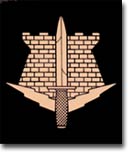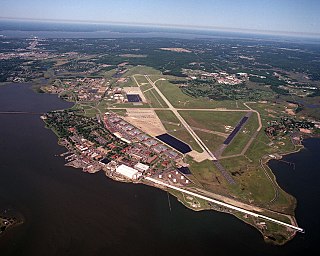Related Research Articles
The Combat Capabilities Development Command Soldier Center, formerly the United States Army Natick Soldier Research, Development and Engineering Center, is a military research complex and installation in Natick, Massachusetts, charged by the U.S. Department of Defense with the research and development of food, clothing, shelters, airdrop systems, and other servicemember support items for the U.S. military. It is a component unit of the United States Army Combat Capabilities Development Command and is a tenant unit of the United States Army Natick Soldier Systems Center (SSC). The installation includes facilities from all the military services, not just the Army, and is so configured to allow cross-service cooperation and collaboration both within the facility and with the many academic, industrial and governmental institutions in the Greater Boston Area.

The 38th Infantry Division is an infantry division of the United States Army and part of the Indiana National Guard. It is headquartered in Indianapolis, Indiana, and contains Army National Guard units from across the Midwest.

A combat medic is responsible for providing emergency medical treatment at a point of wounding in a combat or training environment, as well as primary care and health protection and evacuation from a point of injury or illness. Additionally, medics may also be responsible for the creation, oversight, and execution of long-term patient care plans in consultation with or in the absence of a readily available doctor or advanced practice provider. Combat medics may be used in hospitals and clinics, where they have the opportunity to work in additional roles, such as operating medical and laboratory equipment and performing and assisting with procedures.
Many countries and international organizations offered the United States relief aid in the wake of Hurricane Katrina.

The disaster recovery response to Hurricane Katrina in late 2005 included U.S. federal government agencies such as the Federal Emergency Management Agency (FEMA), the United States Coast Guard (USCG), state and local-level agencies, federal and National Guard soldiers, non-governmental organizations, charities, and private individuals. Tens of thousands of volunteers and troops responded or were deployed to the disaster; most in the affected area but also throughout the U.S. at shelters set up in at least 19 states.

In September 2005, units of the Mexican Armed Forces responded to the emergency situations after Hurricane Katrina with aid and assistance, appearing as a flagged, uniformed force in the United States for the first time since World War II in the 1940s and the first operational deployment of Mexican troops to the U.S. in 159 years.

The Singapore Combat Engineers (SCE) is a formation of the Singapore Army. Combat Engineers provide mobility by bridging gaps and clearing minefields to facilitate speedy advance of troops into enemy territory, and counter-mobility by constructing obstacles such as anti-tank ditches to impede the enemy's movement. The Combat Engineers also construct trenches, drainage systems and other related infrastructure to enhance the survivability of troops during operations.

The Marine Wing Support Squadron 373 is an aviation ground support unit of the United States Marine Corps. They are based out of Marine Corps Air Station Miramar, California. The squadron is part of Marine Aircraft Group 11 and the 3rd Marine Aircraft Wing.

The 13th Armored Corps Sustainment Command—the "Lucky 13th"—is a U.S. Army modular sustainment command which serves as a forward presence for expeditionary operations for a theater, or in support of a regional combatant commander. Corps Sustainment Commands (CSC), such as the 13th, synchronize distribution of supplies and services within their operational areas and provides distribution oversight. Formed at Fort Cavazos, Texas when the 1st Logistics Command deployed to Vietnam, the organization then known as the 13th Support Brigade was initially responsible for the training of technical services units to assume combat service support missions in Southeast Asia.
The 231st Combat Communications Squadron, District of Columbia Air National Guard, was a tenant unit of the 113th Wing based at Andrews Air Force Base, Maryland, United States.

The 53rd Infantry Brigade Combat Team is an infantry brigade combat team of the Florida Army National Guard. The 53rd Infantry Brigade is the largest National Guard unit in the state of Florida. The brigade was one of fifteen enhanced readiness brigades, designed and trained to support active duty divisions. The brigade includes 32 units in Florida and Alabama with 4,166 authorized personnel.

Langley Air Force Base is a United States Air Force base located in Hampton, Virginia, adjacent to Newport News. It was one of thirty-two Air Service training camps established after the entry of the United States into World War I in April 1917.

The 28th Combat Support Hospital was a Combat Support Hospital of the United States Army. It was first constituted in 1943 and served in China during World War II. During the Gulf War in 1990, it was the first Army hospital unit established and deployed into Iraq with combat forces of the XVIII Airborne Corps. More recently it has been involved in relief operations following natural disasters and has undertaken several recent deployments to Iraq. The unit fell under the command of the 44th Medical Brigade and was based at Fort Bragg, North Carolina.

The 104th Cavalry Regiment is a Regiment of the United States Army first established in 1921. Troop A, 1st Squadron is one of several National Guard units with colonial roots and campaign credit for the War of 1812.

Ramadi, the capital of Iraq's Al Anbar Governorate, was under U.S. military occupation during the Iraq War. It was a focal point of Iraqi insurgency, which erupted into open armed conflict in 2004 and in 2006, part of the Iraq War in Anbar Province. Operation Murfreesboro was a U.S. offensive in February 2007 intended to cut off the Ma'Laab district of eastern Ramadi from the rest of the town in order to drive out Zarqawi's Al-Qaeda in Iraq.

Joint Base Lewis–McChord (JBLM) is a U.S. military installation home to I Corps and 62nd Airlift Wing located 9.1 miles (14.6 km) south-southwest of Tacoma, Washington under the jurisdiction of the United States Army Joint Base Headquarters, Joint Base Lewis–McChord. The facility is an amalgamation of the United States Army's Fort Lewis and the United States Air Force's McChord Air Force Base which merged on 1 February 2010 into a Joint Base as a result of Base Realignment and Closure Commission recommendations of 2005.

The 14th Combat Support Hospital is a combat support hospital of the United States Army. It participated in World War II, the Korean War and, more recently, deployed to Afghanistan. The hospital was involved in relief operations following Hurricane Katrina. The unit currently falls under the command of the 44th Medical Brigade and is based at Fort Moore, GA, and relocating to Fort Stewart, GA during FY 2020.

The 158th Cavalry Regiment was a United States Army cavalry regiment, represented in the Maryland Army National Guard by 1st Squadron, 158th Cavalry, part of the 58th Expeditionary Military Intelligence Brigade at Annapolis.
Force Provider is a deployable bare base support system developed by the United States Army to provide rest and relief facilities for soldiers. Each containerized package provides air conditioned/heated billeting, dining, laundry, latrine and recreational facilities for a battalion-sized force of up to 550 soldiers and the 50 personnel required to operate it. Based around the use of TEMPER tents, it includes the capability to store and distribute 80,000 gallons of water, 40,000 gallons of fuel, and generate 1.1 megawatts of continuous power. It takes on average three to four days to prepare a Force Provider camp site, typically 10 acres of land, then five to six days to set it up and make the camp operational. Six packages can be combined to support a brigade-size force of 3,300 soldiers. Although its primary mission is to support front-line soldiers, Force Provider can be utilized for other missions such as humanitarian aid and disaster relief.
A Combat Sustainment Support Battalion (CSSB) is a combat service support battalion of the United States Army. A CSSB can be attached to a sustainment brigade to support the brigade combat teams and support brigades assigned to a corps with maintenance, transportation, supply, field services, and distribution functions. The CSSB is task-organized with the subordinate units necessary to carry out its mission.
References
- ↑ "Supplying the force.(quartermasters)". Soldiers Magazine. 6 January 2005. Archived from the original on 25 January 2013. Retrieved 2006-07-07.
- ↑ "Ramadiyah / Ar Ramadi". GlobalSecurity. Retrieved 2006-07-07.